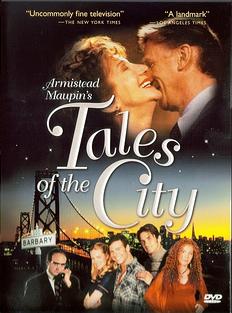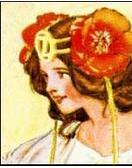I first read Tales of the City in college in the early 90’s. I worked in a bookstore and I knew which books people came in asking for the most, and this was one of those. Tales of the City may be the reason I moved to San Francisco for law school, and it may also be the reason the city failed to live up to my expectations. No Barbary Lane, no Mrs. Madrigal, no cool funky friends for this very straight, very buttoned-up white girl.

I did enjoy living in San Francisco, for what it’s worth. I spent a year living in Twin Peaks and exploring the Castro and Noe Valley, with its small coffee shops and bakeries and bars. I loved its sense of freedom and open sexuality, but I didn’t quite feel I belonged there, and it was a stressful time in my life.
The key thing about Tales of the City, even more than its setting, is the family Maupin creates. Today the “found family” is all the rage, but Maupin practically invented it. Written as a serial in the San Francisco Chronicle in the mid-1970’s, Tales of the City is about Mary Ann Singleton, who moves from Cleveland to San Francisco and finds an apartment – and family – at 28 Barbary Lane.
As a journalist, Maupin began writing fiction a chapter at a time in the Chronicle. The serial took off and eventually Tales of the City was published as his first novel. Maupin wanted his stories to cover real issues of the time, and as the series goes on the books do that more and more. They are also entirely grounded in real places in the Bay Area, like the Bohemian Grove, and Barbary Lane is based on a real street. Many of his characters are based on real people.
There’s an authenticity to Maupin’s writing, partly because he’s always writing about the time and place he’s living in. Maupin doesn’t have his characters drinking Tab because it’s funny, just because that’s what they were drinking at the time. It’s fun to see all the references to 70’s culture and products. It wasn’t written to be literary; it’s a page-turner, a roller-coaster of a story. Because it’s a serial, each chapter is very short and the dialog fast and punchy. It’s at times difficult to keep track of who’s saying what, especially on the audio, narrated by the always wonderful Frances McDormand.
As with a lot of great stories, the main character is far less interesting than the people around her. Maupin writes with heart and with humor, and while his San Francisco is an improbably small town (Mary Ann sleeps with a guy who then sleeps with his wife’s gynecologist who sleeps with MaryAnn’s neighbor), his characters are unforgettable. There aren’t many books where I feel like I know the characters, but if you read the first six books in this series and you aren’t wishing Mouse and Brian were your real best friends, you’ve done it wrong.

There are ten books in the series, and I’ve read eight of them, including Mary Ann in Autumn. I somehow missed Michael Tolliver Lives, which apparently is the most autobiographical of the series, and a new one, Mona of the Manor, has just come out. One thing I love about the series is how each character develops. If you read just the first book, you might feel like the characters aren’t well fleshed out, but each of the main characters grows and changes over time, and not always for the better. This is what makes them feel so real.
I did wonder how this book would hold up today. There’s terminology we wouldn’t use today, and the book is written pre-AIDS so it now has a slightly different feel (Maupin addresses AIDS in later books). With regards to things like racism and homophobia, we certainly haven’t come as far as Maupin probably thought we would. The only part of the book I disliked was the Norman storyline; it doesn’t work very well, and I’m not sure it worked well in the 70s either.
You may know this story from the miniseries made in the 90s that starred Laura Linney and Olympia Dukakis. Mouse and Bryan were relatively unknown actors but surprisingly perfect casting, as were Mona, Beauchamp, and Edgar. The movie did a great job of bringing the story to life. They made a new miniseries in 2019 with many of the same actors, but I haven’t seen it.
My reading of this book will be completely different from someone coming to it for the first time. For me, rereading this favorite was like visiting old friends in a city where I used to live. Only now I’m closer to Anna Madrigal’s age now than Mary Ann’s. I just wish I could have more fully experienced San Francisco the way these characters do.

